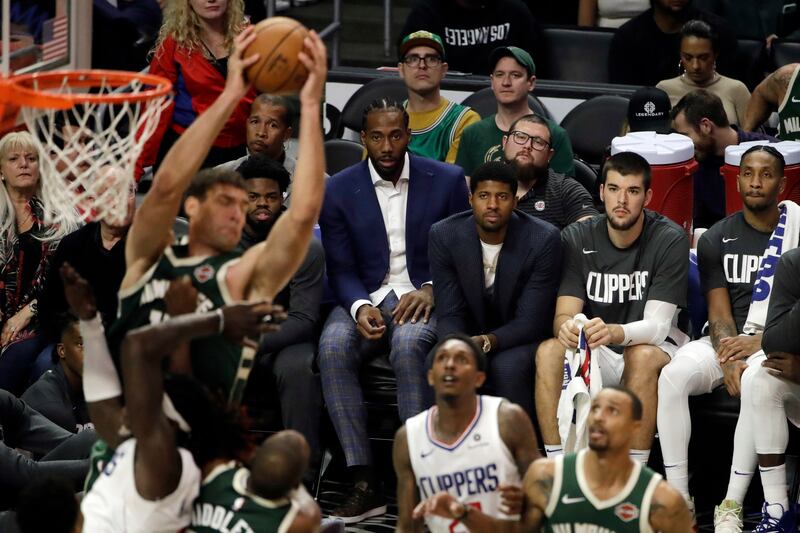Only in professional sports can an employee be paid tens of millions of dollars and not be expected to, you know, work.
Kawhi Leonard, the best player in the NBA, will collect nearly $33 million this season to both play in and watch games. NBA teams call it “load management.” The rest of us call it “a day off.”
NBA teams are benching healthy players for entire games to save them from the wear and tear of the NBA season. Beginning with the 2018-19 season, Leonard has sat out two dozen games, including two already this season.
The NBA, which once tried to stop this practice with fines and warnings, not only has capitulated, but the commissioner stated his approval.
Gone are the days when players prided themselves for showing up every night. Superstar Michael Jordan played 80 or more games 12 different seasons. Karl Malone played in 80 or more games during 17 of his 19 seasons. Ron Boone and AC Green played more than 1,000 consecutive games without “managing their load.”
They did it during an era in which there were frequent games on two or even three consecutive nights, and until the ‘90s teams traveled on cramped airlines and spent days or weeks on the road instead of being whisked home immediately on a private charter jet.
Resting players was anathema to Jerry Sloan, the former Jazz coach. He thought it was a ridiculous notion. He was a farmer at heart — it’s what he did in the offseason — and he treated basketball accordingly. Sloan believed in getting up and going to work every day. He also believed that resting players cheated fans — the people who had real jobs and paid part of their earnings to see players play, not sit. He didn’t have the stomach to tell Joe Fan that his player had sore legs so he wasn’t going to go to work that night.
Teams used to be subtle about resting healthy players, but now it’s out in the open. The Clippers had convinced the NBA this season that they were resting Leonard because of a lingering knee injury. The NBA even released a statement saying they were buying the Clippers’ story. But then Clippers coach Doc Rivers spoiled the whole pretext by telling reporters, “(Leonard) feels great, but he feels great because of what we’ve been doing. We just got to continue to do it. There’s no concern here.”
Leonard sat out that night’s game; Rivers was fined $50,000 by the NBA.
The Warriors and Spurs, among other teams, have practiced “load management” for years, as has LeBron James. The NBA resisted it mostly because when players sat out nationally televised games it threatened the $24 billion contracts they had signed with TV networks. There’s no way to know if this is why TV ratings declined last season.
Leonard has already sat out two of his team’s 10 games this season, including a nationally televised game against the Bucks. Leonard’s “load management” consisted of missing 22 games last season, and then he led the Toronto Raptors to a championship, which of course strengthens the argument that players should be rested throughout the season.
But there’s a broader point to be made about the issue. If players can be rested during the season, that means the games are unimportant, and that’s because there are too many games and too many weak opponents due to the league’s historic lack of parity. There are so many games (82) — and so many meaningless games — that teams can afford to park a player on the bench and not care about winning and losing.
In baseball, resting players is a more acceptable — and accepted — practice. There are 162 regular-season games. Mike Trout and Bryce Harper, two of the leagues’ best players, take games off regularly. This is a rarity in the NFL in which a 16-game schedule and parity make each game important. Patrick Mahomes, the best player in the NFL, plays injured because his team can’t afford a loss. And yet even the NFL might succumb. Last Sunday, Andy Reid rested his healthy running back, LeSean McCoy, for “load management,” and the Rams have cut Todd Gurley’s playing time and touches to keep him healthy.
The NBA of course is already well down that road. Teams rest players because what’s another loss in an 82-game season, especially filled with so many weak opponents. But the Clippers rested Leonard even for a game against the Utah Jazz, a rival Western Conference team and a championship contender, because it was the first night of back-to-back games.
In 2017, commissioner Adam Silver, once an adamant opponent of “load management,” told USA Today that science indicates there is a “direct correlation ... between fatigue and injuries. And as tough as it is on our fans to miss one of their favorite players for a game, it’s far better than having them get injured and be out for long periods of time.”
Or he could simply cut 25 games from the schedule. Make it 22 — the number Leonard rested last season.


